A Conversation with “Head Over Heels” Director Timothy Reckart
A particularly thoughtful and well-executed student film, Tim Reckart’s NFTS graduation short Head Over Heels has been the talk of the stop-motion community for many months now. Taking inspiration from life, love and Rembrandt it tells the story of a housebound couple in their Autumn years, frustrated, acrimonious, floating in limbo and polarized by separate gravitational fields; one person’s floor is the other’s ceiling, and vice versa. In ten minutes the film conveys a beautifully-observed sense of isolation, interdependence, emotional ambiguity and compromise, and it’s no surprise that for its technical excellence and poignant story it has been so acclaimed. As well as being recently praised by Nick Park, one of Reckart’s formative influences, the film’s accolades include an Annie Award for Best Student Film, Special Jury Prize at Cinanima and an Oscar nomination for Best Short Animation. Skwigly recently chatted to Timothy about the coming together of this unique and inspring film.
I gather from your background info that you came to the NFTS after being at Harvard?
I studied history and literature at Harvard and…well, I guess going into Harvard I knew that I wanted to be a filmmaker but also that I didn’t want to study filmmaking as an undergraduate. I guess my feeling was that you can learn form when you go to filmmaking school but you don’t learn any content, and I wanted to be educated before I started telling stories. I started doing animation because no-one had any time to act in any films, so I thought of it as a way I could make a film by myself. So I sort of fell into it and kept falling into it, I got really into it. It was actually the first time I’d ever done stop-motion as opposed to video, so it was kind of fortuitous in that way.
Was that during your time at Harvard or subsequent to it?
While at Harvard. Ruth Lingford – who of course is a British animator – she now runs the animation programme. Ruth has also taught at the NFTS and so it was kind of her idea for me to apply. By the end of Harvard it was clear to me that I wanted to keep doing animation, and she said the NFTS would be great because it’s got that industrial structure where you’re working with a big crew.
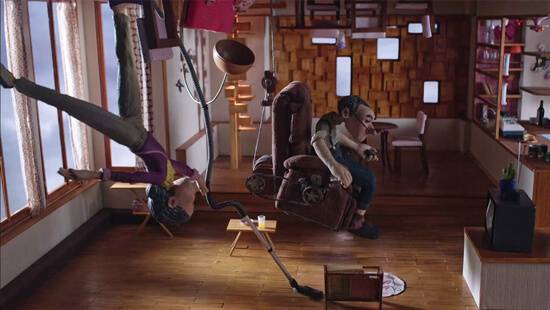
©2012 Tim Reckart/NFTS
I also noticed that you did a bit of work experience at Aardman…
Yeah, I did it twice. The very first year that I did animation I got to do I think four weeks on “Shaun The Sheep”, and that was awesome. From the moment I encountered them I’ve been totally all about Wallace and Gromit, so finally getting to be at Aardman was seriously a dream summer internship. The second time I was there was while I was at NFTS and I did a couple weeks on the “Pirates!” feature, that was really cool too because this time around, being more advanced as an animator myself I was just able to learn more from the people around me. I literally learned about how to animate a good snap in stop-motion while having dessert with one of the crew at lunch. The other nice thing is I can now talk to these guys who have worked at Aardman, like Peter Lord I’ve met at a couple of festivals now and it’s great to be able to say “I worked on your film!”. It’s a nice initiation into the community and the people at Aardman are so friendly to interns who are probably taking up more of their time than they’re actually giving, so they’re so welcoming and really invested in young people who are interested.
So once you’re there at the NFTS how do things progress to eventually lead to the final film? Are there stepping-stones up to that main project?
The first year is all exercises, the second year is all final film. It’s actually kind of minimalistic in a way, you just get in there and do about five or six projects in the first year, then the last year is just spent entirely on this final project. It’s not an academic term year, it goes January to December, so in the last month of the first year we were already sort of generating ideas for “Head Over Heels”.
As the writer of the film was it predominantly your story from the outset?
Yes, I had the idea for the concept during a workshop with the production design students where we were looking at paintings and trying to design spaces inspired by them. There’s this one Rembrandt painting called “Philosopher In Meditation” with this spiral staircase that looked like someone on the ceiling could use it to come down, the same as someone on the floor could use it to go up; It sort of clicked that you could make a film with someone on the ceiling and someone on the floor. So it definitely started with the image of people upside down, they weren’t even married at the beginning, but it just seemed that obviously that has to represent something, and seeing what the most poignant place to put that would be; inside of a marriage where they should be together but they’re not.

“Philosopher In Meditation” – Rembrandt, 1632
When you have that basic concept do you work on your own to develop the story? Do other people come on board?
Early on we get paired up with our student producers, and my producer was very active with the creative process. I think I wrote up an outline to begin with, and then from there it was heavily workshopped. Also going into storyboarding and animatic we had lots and lots of feedback. I guess I was sort of driving that, being the one making the decisions but I had a lot of collaboration, especially from my producer Fodhla. Things like the focus on the shoes, that came at a later stage through the workshopping thing.
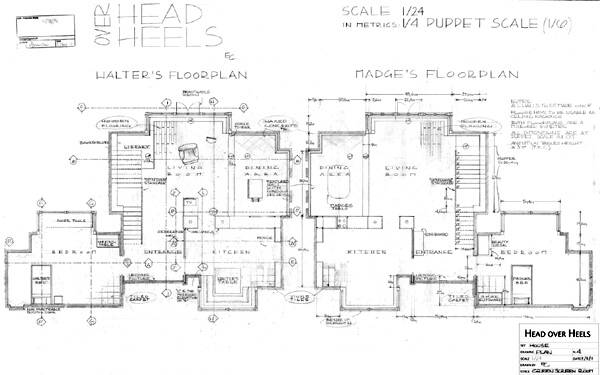
Floorplan by Eleonore Cremonese
The level of detail in the set construction – the niknaks, collectables, that real sense one gets of a life spent together – how much of that is determined by yourself? Does the crew who put together the set throw ideas into the ring also?
They definitely had ideas, I thought of myself more as a filter and less as a generator when it came to the sets. We had a production designer on the film, Eleonore Cremonese, she designed the floor plan. There were rotating volunteers but ultimately I think we had about fifty people come in, all told. Usually there were fifteen to twenty at a time all working on something individually. Eleonore would kind of pull something off Google Images, make some adjustments to it and say “Build something like this”. Of course there are constraints with the materials and you can’t build everything in the way you would envision it so you have to adapt with what you’ve got. But then there’s also the happy accidents of finding things, like her Mother found a few of those little porcelain niknaks at a street fair. A lot of things happened that were not things I asked for but things that I definitely loved once I saw them, like in that house the kitchen sink is brown. I wouldn’t have thought to choose that but it really fit with the aesthetic, it seemed kind of old-school. So that’s where the bonus of having a production designer really comes in because she’s thinking of all these details, for me I would’ve just had a metal kitchen sink as the first thing that came to my brain.
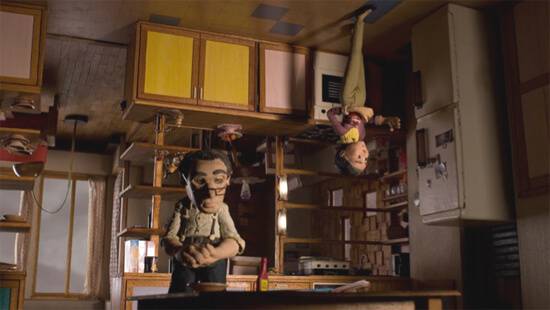
©2012 Tim Reckart/NFTS
Was it a similar collaborative process with the construction and design of the puppets themselves?
I had a couple of graduates from the NFTS work with me on character design, Richard Phelan and Elena Pomares. Elena did the initial concepts and then Rich made them into model sheets, something usable for creating puppets out of. The funny thing was the woman character was black originally. All the Jamaican women in my family have aged very beautifully, also I have an old Jamaican aunt who used to be a ballerina in the New York ballet which inspired that. The thing is, at the animatic a lot of people thought that this was sort of a metaphor about race relations or something. If I’d cast it as a live action film people would’ve just seen the person as a specific individual but because it’s animation, just by definition there’s something that’s immediately interpreted as symbolic, which is appropriate as of course the whole film uses symbols. But it’s not about that, it’s about two people coming together, whether it’s race, religion, politics, whatever.
So anyways, we got those character designs done, then an armature manufacturer in Korea made the armatures and shipped them to a couple of undergrads at Arts University College Bournemouth – their modelmaking BA is ridiculously, amazingly well kitted-out. A lot of stuff is done with silicone these days, but I’m not crazy about the look of it and I love the look of the old “Nightmare Before Christmas” puppets, which are all foam latex, so I wanted that although it’s a more intensive process, you need to be baking these chemicals, you’ve gotta hit the right temperatures and everything. We then had some of our volunteer modelmakers at the NFTS do the detailed painting.
Were the personalities of the characters and the nature of the relationship taken from anyone in particular you know or was it just observational?
Probably, at some level. When I watch it now – not that I was thinking of this then – they do remind me of my grandparents, and I’m sure my concept of what a woman is and what a man is have come from my family background. My grandfather did have his metal shop in the house with all these tools, my aunt was a ballerina, my grandmother plays the piano, so it’s sort of artistic on one side and practical on the man’s side of things. Their relationship came more out of the image than of anything else, but their personalities I do think are based partly on my grandparents, in retrospect.
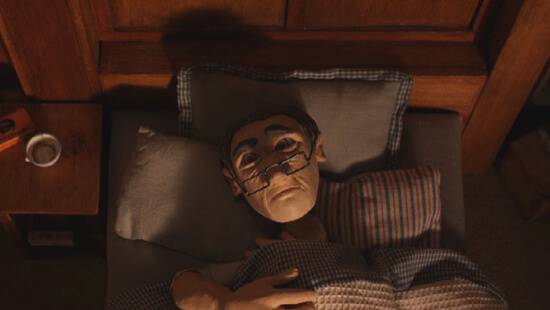
©2012 Tim Reckart/NFTS
I do know at least one couple with whom it resonated with quite strongly, have there been couples who’ve come up to you who’ve been affected by it?
There’ve been a couple of reactions, one of them is a bit wry and seems to focus on “Yeah, I never know what she’s talking about”, but to me the film is definitely about the ending; It doesn’t matter who’s right, it just matters that you fix it. Some people’s reactions have tuned into that, which is to say they’re seeing a glimpse of their own experience where they’ve had to to give up their pride to make sure the marriage is working.
Going back to the technical side of things, and really the thing that sticks out so much is how it was made and animated. As is my understanding it was actually built as an upside-down set rather than composited?
Yeah.
Wow. How do you begin to work that out?
I remember when I pitched the project I thought it was relatively simple, “Okay, we can just build the sets and flip it over and that’s that”, and all the faculty members in the room were like “That’s not how this works”. Basically with sets as big as these were – and we were working at 1/6th scale, the distance from floor to ceiling was about two feet, so these are like big chunks of wood, but flexible and floppy. So the way Eleonore designed the sets was that basically every time we wanted to flip them we just deconstructed them and rebuilt them the other way around.
Everything that’s upside-down in the film was not necessarily upside-down in real life, so every time it was a one-shot that character was right-side-up and we’d just flip the camera. One of the most memorable shots in the film was the one where they’re playing with the refrigerator, that shot is flipped so it was the man who was upside-down when we shot it. That was one of the tricks that was nice to discover: you don’t need to see the floor for the person who’s right-side up, and meanwhile it’s really cool if you can see the floor for the person who’s on the ceiling. So that means we don’t need a floor at all for the main character. That was how we did it. Because of course having a ceiling over the set can be a problem for getting lights in, usually if you’ve got an open ceiling you can get lights in, you can get your hand in there and everything. It meant that it was sort of a cave that you had to worm your way into to adjust the puppets and then kind of slip out. I think actually the hardest thing about animating upside-down was making sure that the gravity was going upwards. I had to be very vigilant about that. Another example I can think of stop-motion being animated upside-down was Wallace in “The Wrong Trousers”, stealing the diamond. That they animated upside-down so that it was easier for the animators to imagine how Wallace should be flopping around, but it was kind of the opposite in this film because we had to invert the thinking and make sure things were falling upwards and hanging upwards, that was the hard part of it.
Were there any elements that turned out better – or not necessarily as good – as what you’d planned?
Well I think the emotional payoff is exactly what I’d wanted it to be from the very beginning. Something about sacrifice, something about “She loves me, even though she doesn’t have to”, that really got preserved. I’m very pleased with that, but getting there and getting that payoff to happen, my original ideas weren’t working so we had to adapt. Originally there was a lot more business going on when she goes out of the house, but ultimately it’s not really about that and so we cut that down. I think the music carries a lot of the weight, and the music came in very late in the process, only a couple of months before the film was totally finished. We’d tried out many different options in terms of the tone, but I think the nostalgic slide-guitar nails it. That music, together with the look of the film to me really is the film, and that’s something that was definitely not there at the start, not even in any sort of pre-visioned form. To me that’s the nice thing about stop-motion is you start at the beginning and you may end up somewhere different by the end than you thought you were going to.
It’s deservedly doing very well. Do you make many festival appearances in person with it?
I go when I’m tempted and just can’t say no, so I went to Japan when it went to Hiroshima, which only happens every two years so I had to go. I also went to Cinanima in Portugal and got my Dad to come along with me, he’s a big lover of wine so we had a great time there. The American festival circuit is of course a little bit easier, I’ve gone to a handful of those, I’d say one out of five. So usually I just send the film, but when a festival can offer some kind of package to make it easier for you to travel it’s really hard to say no.
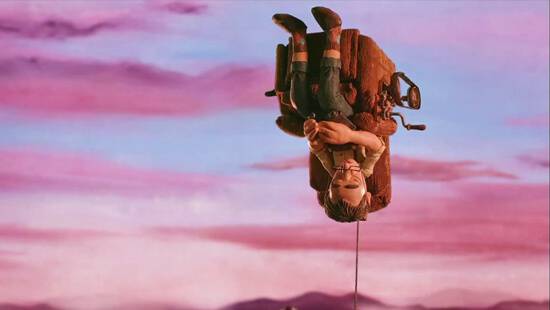
©2012 Tim Reckart/NFTS
Is it mainly on you to get it out there or do the NFTS push it as well?
They do push it, they’re the ones who submitted it to Cannes, they’re the ones who submit it to the big international festivals. The American circuit has been more up to me, but I guess I’d say it’s a joint effort, although they definitely give us the freedom to push it as much as we want.
How excited/nervous are you regarding the current Oscar buzz?
Yeah, it’s a big opportunity which also means there are stakes. The nice thing is the film kind of does its own work. It’s a funny thing as it’s been so long since we actually animated it, and I’ve seen it so many times it actually feels quite distant.
Did you expect the film to get the positive reception it has?
I was definitely hoping for it to do well, of course. I didn’t expect it to do as well as it has. Our world premiere was at Cannes which was the first big surprise, especially because Cannes is more of a live-action film festival. I guess my feeling was that I just wanted to make a film that people would remember. It seemed like a good idea to come out of school with a high-concept film as a calling card. Beyond that I guess also I did kind of consciously choose to do something that was kind of a crowd-pleaser, a film that invested in an emotional payoff – not that they’re mutually exclusive but I think a lot of animated shorts go for some kind of innovation where you’re more aware of the animation technique, while I consciously decided to make everything as human as possible in this film. I think that has had a lot to do with the success of the film as a lot of the awards that we’ve won have been audience awards and it’s an indication of the kind of film that it is. It just means that it’s accessible and it’s conveying something to most people, even if they’re not well-versed in animation.
Are there any projects you’re working on at the moment that you’re able to discuss, like commissions or personal work?
Well, I will say I’m surprised by how much time I’ve had to spend keeping “Head Over Heels” moving on the festival circuit. Now I’m working with some Harvard people on a short project based on some writings by Freud. It’s kind of an interesting change of pace and, in a way, a return to my roots. “Head Over Heels” was actually a departure from a much darker body of work for me. So it’ll be interesting, I get to do some stop-motion somewhat inspired by Quay Brothers and some of those other greasy, grimey looks.
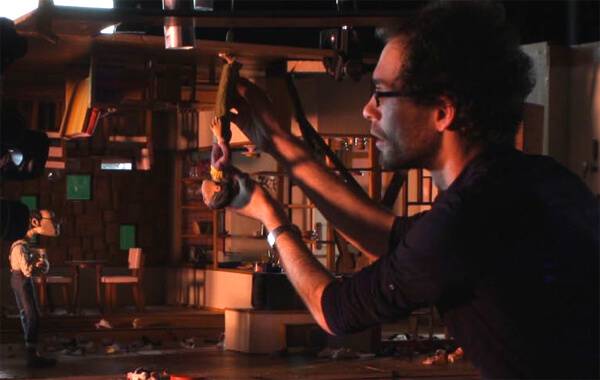
Tim Reckart on set
Is stop-motion your preferred medium then, overall?
Well, I can’t draw and I don’t know how to use Maya (chuckles). I came to it from a live-action background, so to me this is the closest animation medium to live-action, and also to me it just seems intuitive, you don’t need to learn a lot of controls to make the puppet move, you just move it. I have a bit of this micro-managing personality and so it can sometimes be frustrating with actors – in other words, you can actually micro-manage a performance with a puppet and nobody’s gonna get mad at you. That’s one of the reasons the shift from live-action to animation was very satisfying.
For more information on “Head Over Heels” you can visit the film’s official website.
The film is nominated for a Best Animated Short Oscar alongside Adam & Dog (Minkyu Lee) Fresh Guacamole (PES), The Longest Daycare (David Silverman) and Paperman (John Kahrs). The 85th Academy Awards will be held on Sunday, February 24th.

